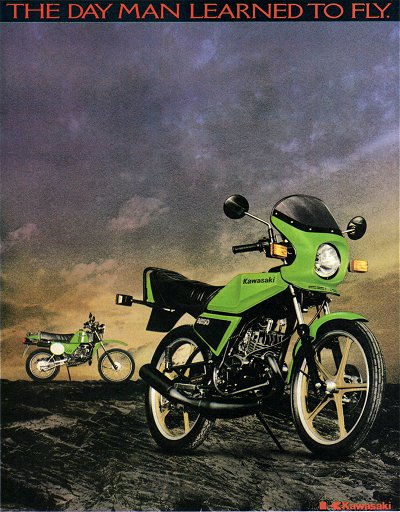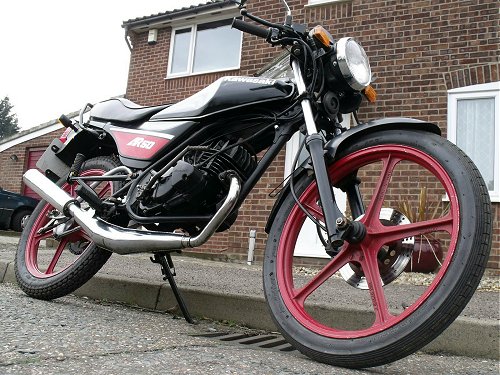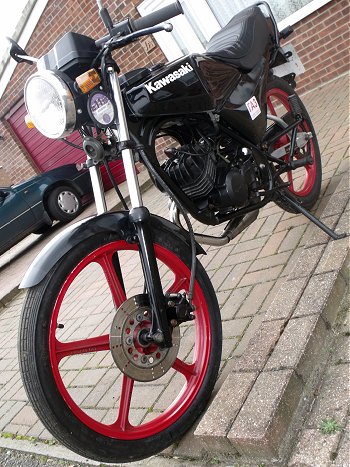

Sponsored by Paul Barber,
East Anglian Cyclemotor Club,
Wiltshire Section

1981 Kawasaki publicity for the AR50 and AE50
Jack walked out of the motor cycle dealers with a big smile on his face, a twinkle in his eye, and a new spring in his step. Sixteen this coming Saturday, and the lad has just signed all the papers to buy his dream machine - a new, jet black, Kawasaki AR50 Sports with red alloy wheels!
Yes, we know there will be some thinking, "What's IceniCAM coming to, doing a modern motor cycle?"
Well, it is the 'oddball' third feature; we thought it might make a change and be interesting in that ... this bike is actually still classed a moped!
Ok, it doesn't have pedals, but the frame plate riveted to the headstock says:
Kawasaki Heavy Industries Ltd.
Moped
49cc
86Kg
30mph
AR050C-026086.
So, irrefutably and according to current specification, it officially is a moped - and anyone having issues with this definition, can write to: The Government, c/o 10 Downing Street, London, SW1.
The history of the moped was redefined on 1st August 1977, when its official description changed from "A machine of engine capacity not exceeding 50cc, and equipped with pedals by means of which it is capable of being propelled", to "A machine of engine capacity not exceeding 50cc, restricted to 30mph, and weighing not over 250Kg". While few of us might care to consider the prospects of any 50cc motor labouring against its own 39 stone chassis, there's absolutely no question that our machine is most definitely a moped that falls within our general 'low powered machinery' brief.
Following the story through, the Kawasaki AR50 was launched in 1981, becoming a machine produced after the definition change and, for the UK, designed specifically to comply with the new 30mph specification. It was further joined by an AE50 street-trials style version.

Our feature machine probably qualifies within that mysterious, and possibly questionable, category of so-called 'Classic Sports Slo-peds', and probably represents a fair example of what the sports moped had become when our bike was bought in 1996.
The appeal of the AR50 to any Jack-the-Lad is easy to see, the 'swept-back' sports styling looks as if it's doing 60mph just when standing still!
With an impressively big-finned, air-cooled, 5-speed motor mounting 14mm carburetter on reed-valve induction manifold, monoshock rear suspension (which Kawasaki called Unitrak), bright red alloy wheels, 80mph Nippon Seiki speedometer, and 11,000rpm tachometer, it certainly boasts a most impressive specification when compared to many of its traditional moped predecessors - so you'd surely be expecting more than 30mph? The reality is that it just looks the part of a proper, fast 30mph sports moped - rather than a slow old 30mph pedal moped.
So what's the first thing that any Jack-the-Lad wants to do when he gets his new sports slo-ped and discovers it really does only do 30?
Yep ... make it go faster!
And how does he do that?
Straight down the local accessory shop and buy a load of custom goodies, the most classic of which would have been a Micron racing expansion exhaust system, with K&N air filter on the carburetter.
Over the years, some might have heard legendary claims of how these bolt-on goodies improve performance, so wouldn't you really like to know?
The particular interest of our feature machine is that it's an absolutely standard bike, fitted with these very screw-fit power parts, so from a restricted sports sloped standard 30mph specification based on a 12 stone rider sitting bolt upright in still air, let's see how it goes...
Fuel turns on at the bottom left of the tank, usually push down the choke lever for cold starting, click on the ignition (we rarely find key switches on the usual vehicles we feature), and fold out the kick-start, which swings out to a wide and ungainly angle for operation.

The kick-starter arm uses half its travel in just loading up the ratchet, then the remaining range barely delivers two rotations of the motor, with the arm clipping the end of the footrest rubber in its downward arc - so it's easy to see how that gets broken!
The kick-starter operation proves uncomfortable and ineffective at starting the motor, and quickly losing interest in further pointless jabbing efforts to encourage the reluctant machine to fire, we resort to a push-start in second. This achieves the desired result, and the engine warbles into life. Once the motor picks up on the throttle, the choke can fairly readily be latched off, and we get underway to escape the growing cloud of two-stroke smoke drifting from the silencer can.
AR has a manual clutch with a 5-speed gearbox, 1 down/4 up with neutral between first and second, while the rider's footrests are positioned in a sporty rear-set arrangement, so the left-foot gear lever is oriented ahead of the toe change. With the low clip-on type sports handlebars, the riding position is quite tucked-in, race style, and very much feels the part.
Getting completely drawn into character for this machine, we give the motor little opportunity to barely warm up, before mercilessly thrashing away to test maximum revs through the gears. Though the tacho impressively indicates the redline at 10,000rpm, reality falls rather short of that fictional illusion. 8,500rpm finds the absolute screaming ceiling in first, at a seemingly promising 20mph, with four more gears still to go. Second stretches to 25mph at 7,500rpm ... third reaches 30 at 6,500rpm ... and fourth struggles to scrape up to a best of 35mph at 6,000rpm sitting upright on the flat. Fifth proves to be little more than a useless overdrive that only drops the revs a bit more and lowers the speed since the motor doesn't produce enough power to pull against the ratio.
So, if the bolt on goodies didn't do the trick, how did you make an AR50 go faster? The AR50 was a popular mount for moped racing in the '80s, and those ones went faster than 30mph ... how was it done?
By using an AR80!
Using the entire bottom end of an AR80 engine complete with 6-speed box, heavier duty clutch, higher capacity oil pump (though some riders prefered to use pre-mix), CDI unit and 18mm carb was a universal modification.
Ignition timing needed to be advanced so it was 1.1mm BTDC at high revs - because of the way the CDI works this made the ignition too far advanced below 7,000rpm, but never mind.
The exhaust from the AR80 or a Micron system were the ones to use, but there wass no need for any fancy air filters - stick with the standard air box.
Then it wass just the barrel and head that needed attention. Legend has it that there was a standard Kawasaki AR50 barrel (US spec maybe?) that would just bolt on and, with the other mods, give an AR50 that was capable of over 60mph. However, if you didn't have one of those, it was time to cut down the barrel and head to raise the compression, open up the exhaust port and change the timing of both exhaust and transfer ports.
Of course, the riders who had the fastest AR50s weren't going to give their secrets away but opening the exhaust port to 70% of the bore and getting it to open 98° BBDC seems to have been common. The transfer ports are big enough, just changing them to open 4° earlier did the trick.
The motor readily faded against headwinds and mild inclines in the higher gears, and it wasn't found to be unusual to have to switch down gears to third against such conditions.
Best on flat with a strong tailwind recorded a flash-reading of 38mph from the pace bike, however the tight crouch position required to achieve this, resulted in a strongly felt discomfort report submitted from the gentleman's department, and certainly wasn't going towards encouraging many similar efforts for very long.
A tight racing 'martyrdom' tuck on the downhill run resulted in the reported delivery of crushed nuts to the delicatessen, for a peak 41/42mph reading on the speedo, but confirmed as actual 39mph by the shadowing pace bike.
On the following ascent back up the other side of the dip, AR50 progressively faded down the gears, fifth ... fourth ... third ... until needing to switch down yet again, and scream the motor up the incline at just 20mph in second to finally manage cresting the rise!
A particularly poor hill-climbing performance, for which we've similarly criticised a number of much older mopeds and antique autocycles in the past, and considering AR's motor specification with a reed-valve too - this really was pretty dismal. One may even go so far to describe this as bordering on the dangerous, since any following vehicle would be impatiently delayed, and probably provoked into some dramatic overtaking gesture.
The overall ride was pretty good; handling was excellent, with the bike very confidently turning through all corners and bumpy bends. The telescopic forks and mono-shock suspension worked very efficiently and delivered a comfortable and stable ride at all times. Both the disc front and rear drum brakes operated very capably within the bike's limited performance.
The 6 Volt DC electrical system with 6 Volt × 25/25 Watt 5½ inch headlamp produces pretty effective night-riding illumination, and the working indicator system can save the rider waving his arms about at times.

Leaning on its side stand at a jaunty angle at the kerbside or on your drive, the Kawasaki lives the boy-racer image and looks the business, but occupies more space inside the crowded garage than an upright bike on a centre stand might, and AR has no facility to even mount such a stand - which presents a number of associated practical difficulties when removing its wheels for service.
The gawky plastic chainguard looks as though it might have been taken off some other bike, but no, it is the original component - just an example of bad-taste, period Japanese styling.
To eyes accustomed to more 'classic' machines, and attuned to more traditional engineering, there appears an over abundance of ill-fitting and soulless plastic parts. While plastic could offer a lightweight option, this isn't converted to any reality by Kawasaki's AR50, as dry weight substantially tips the scales at 86Kg/190lbs. Dragging around 13½ stone of its own deadweight is quite some handicap to consider for a small capacity and restricted power motor.
It's probably going to be hard to pin down every aspect involved in limiting the motor performance to comply with the restriction requirements, but certainly, the compression ratio was reduced to 7:1 for UK spec motors, where US spec listed at 8:1.
UK restricted motors mounted a 14mm Mikuni carburettor, but US spec was a larger 16mm Mikuni.
Where US spec 50s featured a 6-speed gearbox, top gear was simply omitted for the UK market, so only had 5-speeds, and resulted in a 15% lower final drive ratio. The restricted output engine on our test bike could barely even pull its fifth gear, so the sixth would have been utterly useless.
After 15 years on the market, the AR50 was discontinued in 1997.
Next - And now for something completely different! This 75cc recoil-start machine was introduced in 1954.
Now with the 'oddball' third feature, you might be thinking this could be a lawnmower, and we've even pulled that trick before in Lawnrider and Beyond, but not this time. Take your best guess from the clues, but this bike says, "You won't get me, I'm Part of the Union".
[Text and photos © 2010 M Daniels. Period documents from IceniCAM Information Service.]

Our Kawasaki item was very much an opportunist feature, that came about on a visit down to Felixstowe Motorcycle and Auto Centre. Approaching the building, Chris Day was just leaving, having collected his recently reconstructed AR50 from a fresh MoT.
"We could probably cover that in a feature sometime?"
"OK" he says, but it wasn't many months later before we found ourselves cracking on with the job, since Chris was suddenly saying he was going to sell it.
Never intended for anything other than the third 'oddball' slot, the bike went through a quicky road test and photoshoot in early April 2010 and, since there wasn't really anything else in place for the third slot of this September edition, Jack the Lad was suddenly lining up on the fast track.
The pictures were a classically low-effort photoshoot, just wheel the machine over the road and stand it on the neighbour's drive since they have a convenient line of paving blocks to make the bike stand up straighter on the side stand (no centre stand), and the sun just happened to be shining on that side of the road. The light brick coloured background made an effective contrast to pick out the black bike against, nice and simple, avoided cluttered detail, but looked quite typical of such a machine, jauntily posing on a drive. The AR's sporty styling and angular lines just shouted for a 'punchy' photographic style and low-angle shots, and all the pictures just naturally seemed to work out so well - sometimes just keeping things simple is actually best!
From an initial draft with test notes, a research pack went out to the Mediterranean with Danny later in the month, and came back barely two weeks later as yet another fresh article from the very productive Cyprus 2010 batch.
The third slot always seemed most suitable for this relatively modern sports slo-ped, but did allow an unusual angle to the text presentation. Though not generally typical of our more usual aged generation machinery, we were fairly happy that it was a worthwhile article, and that many people would probably appreciate it all the same.
Getting into the research, it's amazing to think that Kawasaki introduced the AR50 in 1981 - nearly 30 years ago, how time flies!
Production costs were very low, barely £5 for fuel and local running, so a real bargain article, and kindly sponsored by Paul Barber of EACC Wiltshire Section.
Complementing the Motom 60S and Sun Hornet with the Kawasaki AR50, we wonder how many people actually noticed that all three feature machines never had a pedal between them? We don't think that really matters too much though, since all the machines pretty much fall within our general small capacity brief, and as long as the articles make interesting reading, figure that's good enough for most folks.